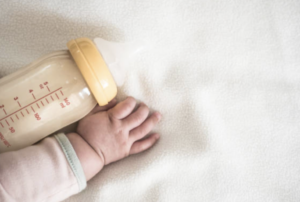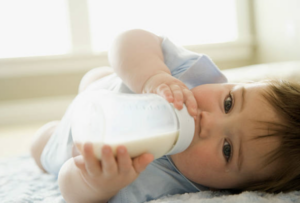A Guide to Navigating Non-Toxic Baby Bottles

Congratulations on becoming a parent! You’re about to embark on a beautiful journey filled with countless cuddles, coos, and of course, a never-ending stream of decisions. One of the first hurdles you might face seems simple on the surface: choosing a baby bottle. But venture into the baby aisle of any store, and you’ll be met with a dizzying array of options, each promising to be the “perfect” choice for your precious little one.
However, in this jungle gym of choices, prioritizing your baby’s health and safety should be your top priority. That’s where non-toxic baby bottles come in. This guide will equip you with the knowledge you need to navigate the world of non-toxic bottles, understand the key factors to consider, and ultimately choose the one that best suits your baby’s needs and your lifestyle.
Why Non-Toxic Matters
A baby’s developing body is incredibly sensitive, constantly absorbing information from the world around them. This is why it’s crucial to minimize their exposure to harmful chemicals. Certain plastics, for instance, can leach chemicals like bisphenols (BPA) and phthalates, which have been linked to potential health concerns. By opting for non-toxic baby bottles, you’re giving your baby the safest start possible.
Choosing non-toxic materials goes beyond just health. It also provides peace of mind. Knowing that your baby’s bottle isn’t leaching any harmful chemicals allows you to focus on the joys of parenthood, not worry about potential risks.
Exploring the Top Contenders in Non-Toxic Bottles
Now that you understand the importance of non-toxic materials, let’s delve into the different options available. Here are the top contenders in the non-toxic bottle arena, each with its own unique set of advantages and considerations:
- The Timeless Classic: Glass Bottles
Glass has been a trusted material for baby bottles for generations, and for good reason. It’s naturally inert, meaning it won’t react with milk or formula, and doesn’t leach any chemicals. This makes it a fantastic choice for parents seeking a completely non-toxic option. Additionally, glass is naturally antibacterial and very easy to clean, which is a major win for busy parents.
However, glass bottles do come with some drawbacks. They can be heavier than plastic or stainless steel bottles, which might be a concern for some parents, especially when traveling or feeding on-the-go. Another consideration is their fragility – glass bottles can break if dropped, posing a potential safety hazard.
- The Eco-Conscious Choice: Stainless Steel Bottles
For parents who value sustainability and durability, stainless steel bottles are a fantastic option. They’re incredibly lightweight and virtually unbreakable, making them perfect for clumsy parents (we’ve all been there!). Additionally, stainless steel bottles excel at maintaining temperature, keeping formula warm or breastmilk cool for longer periods.
The potential downside of stainless steel is that some parents find it can impart a slight metallic taste to the liquid inside. However, many brands now offer bottles with a double-walled design or interior silicone coating to minimize this issue.
- The Soft Embrace: Silicone Nipples
While not a bottle material itself, silicone nipples deserve a special mention when discussing non-toxic baby bottles. Silicone is a safe and popular choice for many parents. It’s soft and flexible, mimicking the feel of a mother’s breast, which can help with latching and reduce nipple confusion for breastfed babies. Additionally, silicone is naturally durable and easy to clean, making it a convenient and long-lasting option.
Finding the Perfect Fit: Beyond Material – Size, Shape, and Nipple Flow
Choosing the right material is just the first step in your non-toxic bottle journey. Here are some other crucial factors to consider to ensure your baby has a comfortable and efficient feeding experience:
- Size Matters: This might seem obvious, but the size of the bottle should be appropriate for your baby’s age and feeding habits. Newborns will obviously need smaller bottles to comfortably hold and manage the flow of milk. As your baby grows and their appetite increases, you can gradually transition to larger bottles.
- Shape Up for Success: Bottles come in a variety of shapes, each with its own advantages. Wide-neck bottles are generally easier to clean due to their wider opening. Angled bottles, on the other hand, can promote better burping for gassy babies. Ultimately, the best shape depends on your baby’s individual needs and feeding style.
- Nipple Flow: A Delicate Balance: The flow rate of the nipple should match your baby’s sucking strength. A slow flow nipple is ideal for newborns who are still mastering the art of coordinated sucking. Conversely, a faster flow nipple might be better suited for older babies who drink more vigorously. Observe your baby’s feeding cues to determine the ideal flow rate. If they seem frustrated or take too long to finish a bottle, the flow might be too slow. Conversely, if they seem to choke or sputter, the flow might be too fast.
The Trial and Triumph of Bottle Selection
Remember, every baby is unique. The “perfect” bottle for one baby might not be ideal for another. Don’t get discouraged if your little one doesn’t take to a bottle immediately. Babies have preferences, just like adults! Be patient and experiment with different shapes, sizes, and nipple types to find what works best for your little one.
Here are some tips for a smooth transition to bottle feeding:
- Start Early: If possible, introduce a bottle early on, even if you’re primarily breastfeeding. This can help your baby become comfortable with the concept of bottle feeding and prevent nipple confusion later.
- Let Dad or a Caregiver Take the Lead: Sometimes, babies can be more receptive to a bottle if it’s offered by someone other than the primary caregiver. This can help establish bottle feeding as a normal part of their routine.
- Warm it Up: Some babies prefer their milk or formula warmed to a specific temperature. Experiment with different temperatures to see what soothes your baby the most.
Balancing Sustainability with Baby’s Needs
Many parents today are concerned about the environmental impact of their choices. While navigating non-toxic bottles, it’s natural to consider the environmental footprint of each option. Here’s a breakdown to help you make an informed decision:
- Glass Bottles: While fantastic from a non-toxic perspective, glass bottles are energy-intensive to produce and transport. Additionally, broken glass can contribute to landfill waste.
- Stainless Steel Bottles: These are a durable and long-lasting option, reducing waste. However, the manufacturing process of stainless steel can have environmental implications.
- Silicone Nipples: Silicone is a generally recyclable material, making it a more sustainable choice compared to traditional plastic nipples.
Ultimately, the best choice depends on your individual priorities. If sustainability is paramount, consider a stainless steel bottle with a long lifespan or a recyclable glass bottle used with care to avoid breakage.

Frequently Asked Questions
Q: Are all plastic bottles bad?
A: Not all plastics are created equal. Look for bottles made from food-grade, BPA-free plastics. However, even BPA-free plastics might contain other chemicals, so non-toxic alternatives like glass or stainless steel are generally preferred.
Q: How often should I replace my baby’s bottle?
A: It’s recommended to replace bottles every 3-6 months, or sooner if there are any signs of wear and tear, cracks, or cloudiness in the material.
Q: What are some additional features to consider in a non-toxic bottle?
A: Look for bottles with anti-colic vents that can help reduce gas and fussiness. Leak-proof lids are also a lifesaver for on-the-go feeding. Additionally, some bottles come with interchangeable parts, allowing you to adjust the nipple size or bottle size as your baby grows.
By understanding the different non-toxic options, the key factors to consider, and the potential trade-offs, you’re well on your way to choosing the perfect bottle for your precious little one. Remember, there’s no one-size-fits-all answer, and the best bottle is the one that promotes safe and comfortable feeding for your baby. Now, armed with this knowledge, you can confidently navigate the world of non-toxic baby bottles and embark on a happy and healthy feeding journey with your little one!

